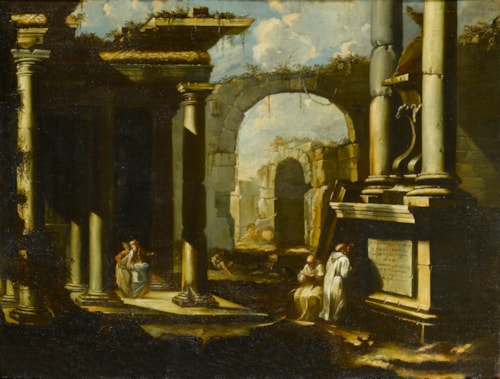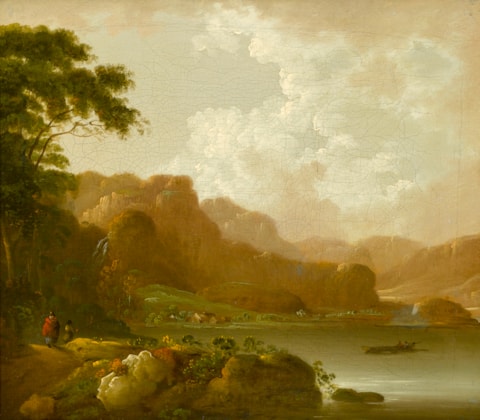enedetto Luti
(Florence 1666 - Rome 1724)
Portrait of a Young Girl
oil on canvas
41 x 31.8 cm (16¼ x 12½ in)
This delightful portrait shows a young girl gazing outside the picture plane to her right. Her porcelain skin is creamy and radiant and her cheeks shimmer with a hint of pink. She wears a simple blue and ochre gown, accessorised with a delicate gold chain necklace and a single drop earring, while her hair is loosely tied in a chignon. There is a great sense of simplicity and charm in Benedetto Luti’s Portrait of a Young Girl. The artist has evidently taken great enjoyment in capturing the innocence and youth of this pretty young girl whose attentions are directed elsewhere.
Benedetto Luti was a master of suave portraiture. He was one of the greatest colourists in eighteenth-century Rome and his chalk and pastel studies of single heads, bust-length apostles, saints, angels and children are charming in their polished freshness and elegance.
An excellent example of Luti’s refined portraiture is held in the Hermitage. A Boy with a Flute shows a young boy in almost exactly the same pose as the girl in the present work. In his hand he holds a flute though he appears to have been distracted by something unknown to the viewer. As in the present portrait, Luti has applied skilful colouring and flowing brushwork to achieve a subtle luminosity that is particularly lustrous in the boy’s curled hair and rosy cheeks. In a strikingly similar manner, the innocence of youth is clearly evident in this intimate portrait of adolescence.
Luti was one of the most influential Roman artists at the turn of the eighteenth century. Born in Florence, he left the city for Rome in 1690 where he painted in the Roman classical tradition emulating the works of Raphael (1483-1520), Annibale Carracci (1560-1609), Guido Reni (1575-1642) and Domenichino (1581-1641). He quickly rose to prominence and was elected to the Accademia di S. Luca. He received commissions from some of the leading families of Rome including the Torri, Colonna, Pallavicini, Barberini and Odescalchi, as well as enjoying the patronage of Pope Clement XI. He was part of the most important papal commission of the eighteenth century - a series of Old Testament prophets (his contribution being Isaiah, 1718) - above the nave arcade in S. Giovanni in Laterano. Luti was also patronised in Florence by Grand Duke Cosimo III de’ Medici and his connections with the Tuscan court helped his reputation spread to France, England and Germany.
We are grateful to Professor Giancarlo Sestieri for proposing the attribution of the present work to Benedetto Luti and for suggesting that it is a painted version, with some differences, of a pastel in the collection of the Earl of Leicester, Holkham Hall. Another version in pastel is in the Galleria Palatina, Palazzo Pitti, Florence.
This delightful portrait shows a young girl gazing outside the picture plane to her right. Her porcelain skin is creamy and radiant and her cheeks shimmer with a hint of pink. She wears a simple blue and ochre gown, accessorised with a delicate gold chain necklace and a single drop earring, while her hair is loosely tied in a chignon. There is a great sense of simplicity and charm in Benedetto Luti’s Portrait of a Young Girl. The artist has evidently taken great enjoyment in capturing the innocence and youth of this pretty young girl whose attentions are directed elsewhere.
Benedetto Luti was a master of suave portraiture. He was one of the greatest colourists in eighteenth-century Rome and his chalk and pastel studies of single heads, bust-length apostles, saints, angels and children are charming in their polished freshness and elegance.
An excellent example of Luti’s refined portraiture is held in the Hermitage. A Boy with a Flute shows a young boy in almost exactly the same pose as the girl in the present work. In his hand he holds a flute though he appears to have been distracted by something unknown to the viewer. As in the present portrait, Luti has applied skilful colouring and flowing brushwork to achieve a subtle luminosity that is particularly lustrous in the boy’s curled hair and rosy cheeks. In a strikingly similar manner, the innocence of youth is clearly evident in this intimate portrait of adolescence.
Luti was one of the most influential Roman artists at the turn of the eighteenth century. Born in Florence, he left the city for Rome in 1690 where he painted in the Roman classical tradition emulating the works of Raphael (1483-1520), Annibale Carracci (1560-1609), Guido Reni (1575-1642) and Domenichino (1581-1641). He quickly rose to prominence and was elected to the Accademia di S. Luca. He received commissions from some of the leading families of Rome including the Torri, Colonna, Pallavicini, Barberini and Odescalchi, as well as enjoying the patronage of Pope Clement XI. He was part of the most important papal commission of the eighteenth century - a series of Old Testament prophets (his contribution being Isaiah, 1718) - above the nave arcade in S. Giovanni in Laterano. Luti was also patronised in Florence by Grand Duke Cosimo III de’ Medici and his connections with the Tuscan court helped his reputation spread to France, England and Germany.
We are grateful to Professor Giancarlo Sestieri for proposing the attribution of the present work to Benedetto Luti and for suggesting that it is a painted version, with some differences, of a pastel in the collection of the Earl of Leicester, Holkham Hall. Another version in pastel is in the Galleria Palatina, Palazzo Pitti, Florence.





 contact
contact contact
contact +44 20 7313 8040
+44 20 7313 8040









